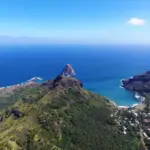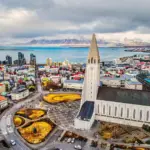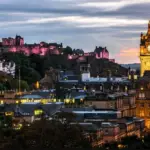The Unparalleled Charm of Namibia

THE Namibia Namibia is a captivating destination that offers travelers a unique experience. Located in southwest Africa, this extraordinary nation boasts stunning landscapes, a rich culture, and a fascinating history. With its combination of vast deserts, diverse wildlife, and traditional communities, Namibia has something to offer for everyone.
A Land of Geographical Contrasts
Namibia's geographic location contributes to its exceptional natural beauty. The country boasts one of the largest desert expanses in the world, the Namib Desert.
This arid expanse encompasses much of the Namibian coastline and boasts stunning landscapes, such as the famous red dunes at Sossusvlei. However, Namibia offers much more than just deserts.
One of the main highlights is the National park Etosha, a wildlife sanctuary home to majestic elephants, powerful lions, and imposing rhinos. Safaris in this park provide visitors with the opportunity to witness nature at its wildest.
A Fascinating Historical Past
Namibia's historical context also contributes to its unique charm. Over the centuries, the country has been influenced by various European cultures and colonial empires. Namibia was a German colony in the late 19th century and later came under South African administration.
Independence was achieved only in 1990. This rich and complex history is reflected in the architecture of Namibian cities.
In Windhoek, the capital, you'll find German colonial buildings that contrast with the city's modern structures. This blend of architectural styles creates a unique and charming atmosphere.
In short, Namibia captivates travelers with its incomparable natural beauty, its diverse culture and its historical past intriguing. Whether exploring the vast plains of the Namib Desert or immersing yourself in the rich culture of Namibia's indigenous people, this country offers an experience that awakens the senses and nourishes knowledge.
what to do in Namibia
Namibia is a country with many interesting tourist attractions. Below are some of the main attractions and landmarks you can visit during a trip to Namibia:
- National park from Etosha: This park is one of Namibia's top tourist destinations and is known for its wide variety of wildlife, including elephants, lions, giraffes, rhinos, and more.
- Sossusvlei: This is one of Namibia's most famous attractions, a red sand desert with tall, impressive dunes. It's a great place to hike and take photos.
- Skeleton Coast: This desolate and remote coastal area is known for its shipwrecks and whale skeletons. It's an interesting place to visit for those who enjoy unusual landscapes.
- Swakopmund and Walvis Bay: These are two coastal towns that are popular with tourists. Swakopmund is known for its German colonial architecture, and Walvis Bay is a great place for birdwatching and a boat trip to see dolphins and seals.
- Damaraland: This is a mountainous region in central Namibia that is known for its stunning scenery and wildlife, including desert elephants and black rhinos.
- Luderitz: This is a coastal town in southern Namibia that is known for its German colonial architecture and its proximity to the Sperrgebiet Nature Reserve, which is a great place for bird and wildlife watching.
- Deadvlei: This is a dry valley in the Sossusvlei Desert, known for its dark, dead trees contrasting with the red sand dunes. It's a great place for photography.
- Windhoek: This is the capital of Namibia and is a great place to experience local culture and visit museums and art galleries
- Kolmanskop Ghost Town: This is an abandoned ghost town built during the Namibian diamond rush. It's a great place to visit for history and architecture enthusiasts.
- Twyfelfontein: This archaeological site contains some of the oldest cave paintings in Africa. It's a great place to visit for those who enjoy history and archaeology.
- Spitzkoppe: This impressive rock formation is known as the "Matterhorn of Namibia." It's a great place for hiking and climbing.
- Big Daddy Dune: This is one of the highest dunes in the Sossusvlei desert and is a great place to walk and take photos.
- Orange River: This river forms the border between Namibia and South Africa. It's a great place for a boat or kayak trip.

Impressive geography and landscapes
vast plains of the Namib Desert
Namibia is a country of incredible contrasts, and its desert landscape is one of its most striking features. The Namib Desert stretches along the Atlantic coast and covers a large portion of the country. Its vast, arid plains are punctuated by imposing rock formations, creating a breathtaking landscape.
The Namib Desert is considered one of the oldest places on Earth and boasts some of the highest dunes in the world. This isolated region offers visitors the opportunity to experience the vastness of the desert while enjoying its unique beauty.
Highlighting Etosha National Park, with its diverse wildlife
THE Etosha National Park is another geographic highlight of Namibia. Spanning approximately 22,270 km², this park is known for its abundant wildlife and for being home to some of Africa's rarest and most endangered species. While exploring the park, visitors can expect to encounter majestic elephants, critically endangered black rhinos, imposing lions, and even elusive leopards in their natural habitat.
The park also boasts a giant salt lagoon called Etosha Pan, which attracts an impressive variety of birds and thirsty animals. Safaris in National park Etosha provides a unique and rewarding wildlife viewing experience in a truly spectacular setting.
the red sand dunes at Sossusvlei and the dramatic Atlantic coast
Another stunning landscape Namibia has to offer is Sossusvlei, an area home to some of the tallest and reddest sand dunes in the world. These dunes, formed by the interplay of wind, sun, and the dry bed of the Tsauchab River, create a surreal, dreamlike landscape. The soft morning or afternoon light enhances the vibrant colors of the dunes, providing incredible photo opportunities.
Additionally, near the Atlantic coast, visitors can witness a dramatic landscape with rugged cliffs and stunning beaches. The region known as Skeleton Coast is famous for its abandoned shipwrecks that contrast with the intense blue sea in the background.
This stunning coastline offers travelers a unique glimpse into the relentless force of nature. Exploring Namibia's diverse geography, visitors are treated to spectacular vistas that leave a lasting impression.
From the vast plains of the Namib Desert to Etosha National Park with its diverse wildlife, the towering dunes of Sossusvlei, and the dramatic Atlantic coast, Namibia offers a truly unparalleled geographical experience. These stunning landscapes are a powerful reminder of beauty and grandeur of nature, inviting travelers to explore and marvel at all that this extraordinary country has to offer.

Rich and diverse culture Exploring the traditions of indigenous peoples such as the Himba and San (Bushmen)
Preserving Roots: Traditions of Indigenous Peoples
Namibia is a country of impressive cultural diversity, home to several ethnic groups. Notable among them are the Himba and the San, also known as Bushmen. The Himba are a semi-nomadic people who inhabit primarily the northwest region of the country.
Their culture is deeply rooted in ancestral traditions, including the use of distinctive traditional clothing and a lifestyle centered on livestock raising. This community has preserved its cultural practices over the centuries, despite increasing Western influence.
The San are considered one of the oldest indigenous peoples of Namibia. They are hunter-gatherers who primarily inhabit the Kalahari Desert.
The San culture is rich in oral traditions passed down through stories and sacred rituals. Their hunting and gathering skills have been essential to their survival in this harsh environment over the centuries.
Furthermore, their in-depth knowledge of the local flora and fauna has contributed to important scientific discoveries. German influence on colonial architecture in cities like Windhoek is particularly noteworthy.
A Historical Portrait: German Influence on Architecture
Namibia has an interesting colonial heritage, with a notable German influence evident in its architecture. In the capital, Windhoek, you'll find a unique blend of colonial and modern buildings.
During the German colonial period in the late 19th century, many buildings were constructed in the style of the time. The Namibian Parliament Building and the Christuskirche are iconic examples of this architectural influence.
German colonial architecture in Windhoek also reflects Namibia's indigenous influences. Architects often combined European elements with traditional styles to create a unique aesthetic.
Furthermore, this cultural fusion is evident in other Namibian cities, such as Swakopmund and Lüderitz. Mention the official languages—English, German, and Afrikaans—and their respective cultural contributions.
Living Language: Contributions from Official Languages
Namibia is a multilingual country with three official languages: English, German and Afrikaans. This linguistic diversity reflects the country's diverse historical influences. English is widely used in public administration and the Namibian education system.
Its adoption as an official language has brought benefits to the economy and tourism, facilitating communication with international visitors. German, in turn, is a legacy of German colonization in the 19th century.
Although not as widely spoken as English, it is still used by some communities and has influenced the country's architecture and culture. Afrikaans is a Dutch-derived language that was brought to Namibia by South African settlers.
It is widely spoken by the Boer-descended community (a people of Dutch origin) and has contributed to the country's cultural diversity. These official languages not only reflect Namibia's diverse historical influences but also play an important role in preserving the cultural traditions of these linguistic communities.
Sustainable Ecotourism Discussion
Environmental preservation and sustainability have become increasingly important in the tourism industry. Namibia has distinguished itself as a destination that embraces sustainable ecotourism practices, ensuring the protection of nature and promoting authentic experiences for visitors.
One of the key aspects of sustainable ecotourism in Namibia is its focus on community-based tourism. Several local communities have actively engaged in tourism development in their territories, allowing visitors to experience their culture and traditions while directly contributing to their economic well-being.
This approach ensures that the benefits of tourism are shared fairly and equitably. Furthermore, strict measures are implemented to minimize the environmental impact of tourism in Namibia.
For example, safari operators are required to follow strict guidelines to avoid disturbing wildlife and cause minimal damage to natural habitats. Permits for tourism activities are regulated, limiting the number of visitors in certain sensitive areas.

Conclusion
Namibia proves to be an exemplary model when it comes to sustainable ecotourism.
By promoting an approach based on local communities and environmental protection, the country creates a unique opportunity for travelers to experience its natural beauty while contributing positively to community development and environmental preservation. When visiting Namibia, tourists have the opportunity to experience impressive cultural and scenic diversity, while also knowing they are participating in responsible tourism.
This awareness is essential to ensure that future generations can also enjoy these natural treasures. Therefore, when planning a trip to Namibia, consider choosing companies and operators committed to sustainable ecotourism.
This way, you'll be contributing to nature conservation and helping local communities thrive in a fair and equitable way. Discover the wonder of Namibia while being part of the solution for a more sustainable future.
Lucas Wanderlust has a tireless spirit of adventure, always seeking new travel experiences. Fascinated by the world and the possibility of exploring unknown destinations, he fell in love with the sense of freedom and self-discovery that traveling alone provides. With a backpack on his back and a heart open to the unknown, Lucas embarks on exciting journeys, where each destination becomes a unique chapter in his life story. He gives himself body and soul to the magic of solo travel, inspiring others to follow in his footsteps and discover themselves through adventure.







